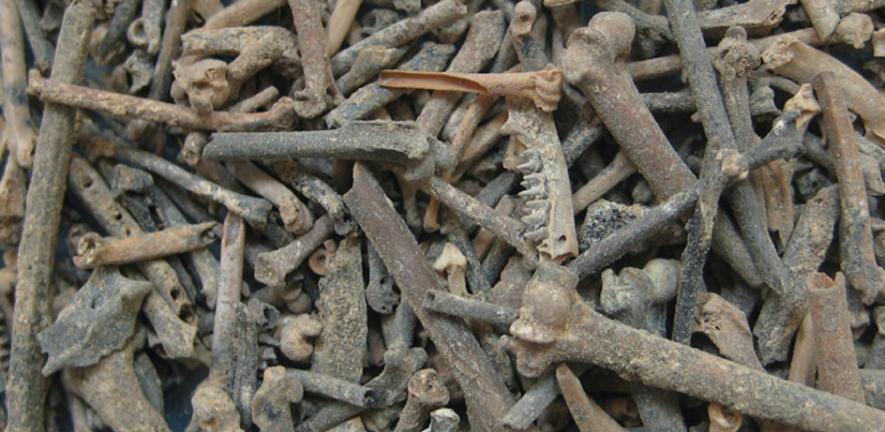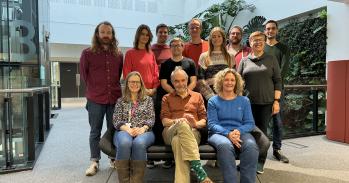
A new study of tropical forests will provide a 50,000-year perspective on how animal biodiversity has changed, explored through an archaeological investigation of animal bones.
A new study of tropical forests will provide a 50,000-year perspective on how animal biodiversity has changed, explored through an archaeological investigation of animal bones.
The study of ancient animal bones can provide a remarkably long-range perspective. It can tell us about the nature of animal communities before humans intensively modified their habitats.
Dr Chris Stimpson
As dawn breaks, a Cantor’s Roundleaf bat flies through the lush rainforest canopy searching out its colony. Its home is the Great Cave of Niah, Sarawak, in northern Borneo, where it accompanies tens of thousands of other bats, careening through the cave after a night’s work hunting insects. It’s a scene that has probably been replicated daily for tens of thousands of years.
Evidence for the longevity of bat colonisation of the cave has been revealed through analysis of some 12,000 bat bones, as well as 1,400 bird bones, uncovered by archaeologists digging in Hell Trench at the West Mouth of the cave, and examined and dated by Cambridge zooarchaeologist Dr Chris Stimpson. His recently completed study, which was funded by the Natural Environment Research Council, suggests that bats have been living there for 50,000 years.
The forest surrounding the Great Cave of Niah once blanketed the entire state of Sarawak, but today only pockets remain such as the Niah National Park, where the cave is located. Conservation efforts here and elsewhere in the world are faced with the challenge of how best to manage and conserve what is left of some of the most biologically diverse and complex habitats on Earth.
Stimpson, along with other zooarchaeologists around the world, believes he has something new to offer the debate: “Conservation efforts draw on relatively recent ecological evidence. To formulate effective priorities for biological conservation, zooarchaeology, or the study of ancient animal bones, can provide a remarkably long-range perspective. It can tell us something about the nature of animal communities before humans intensively modified their habitats, as well as provide a deeper understanding of the role that humans have played in structuring tropical forests across millennia.”
Tall, moisture-loving, closed-canopy forests form a band around the equator and have been described as of “disproportional importance” in driving patterns in global biodiversity and the global carbon cycle. The ambitious study begun by Stimpson will measure changes in animal communities in tropical forests over 50,000 years and across three continents.
The bare bones
The idea behind the new study grew out of Stimpson’s PhD research at the Great Cave as part of a major research project begun in 2000 under the leadership of Graeme Barker, Disney Professor of Archaeology and Director of the McDonald Institute for Archaeological Research in Cambridge. The long-term investigation, which was funded principally by the Arts and Humanities Research Council, involved a team of 40 archaeologists and environmental scientists from a dozen universities. The team found astonishing evidence for sophisticated methods used by early Modern Humans to exploit the rainforest as far back as 45,000 years ago, from specialist hunting techniques to the neutralisation of poisons.
Famously, the oldest reliably dated Modern Human fossil in Southeast Asia yet recorded, known as ‘Deep Skull’, had previously been discovered within the cave in the 1950s by Tom and Barbara Harrisson. As a result of Barker’s research, its age was confirmed as 37,000 years old.
“There had been some debate as to whether the rainforests were a major barrier to the dispersal of modern humans because of the difficulties of foraging in an environment where food is widely dispersed and ephemeral, and sometimes inaccessible in the canopy. But the findings in the Great Cave showed that they weren’t flailing around. They coped well, were thinking ahead and adapting to change,” said Stimpson.
Tropical forests such as the Niah National Park are often regarded as the world’s last ‘virgin landscapes’. Yet this runs contrary to Stimpson’s and others’ findings, as he explained: “These communities may have been subject to exploitation and modification by humans for thousands of years. Essentially, what we regard as ‘pristine’ ecosystems are in fact ‘degraded’ ecosystems. Zooarchaeology can help those involved in conservation efforts to understand how ecologically representative remnant stands of forest are."
After painstakingly analysing the vast number of animal bones found in the cave, Stimpson discovered that people were hunting hornbills at least 19,000 years ago and eating cave-dwelling fruit bats 42,000 years ago. He was able to identify bones from four species of hornbill, although only a single species remains in the forest today.
Using the distal part of the humerus bone (close to the elbow) as a taxonomic marker to differentiate between species of bat, Stimpson found that a colony of wrinkle-lipped bats, which may have numbered as many as three million individuals at its peak, had disappeared by the 17th century: “This may be because the colony was disturbed when people began to visit the cave regularly to collect the nests of cave swiftlets, whose edible nests were much prized as the main ingredient of bird’s nest soup,” he said.
By contrast, he found evidence to suggest the persistence of the Strategy I bats, a guild of bats that need closed-canopy forest to hunt. “If you lose the closed-canopy forest, then you lose this group of bats,” he explained. “This finding presents a robust case for the existence of closed-canopy rainforest for at least 50,000 years, putting starkly into perspective the fact that recent forest felling has reduced the forest by two thirds in the past 40 years.”
Looking for ‘lost worlds’
“Attempts to contextualise and quantify the extent of human impact on the biodiversity and resilience of the tropical forest are hampered by the lack of studies that consider tropical forests from millennial timescales,” Stimpson said. “Yet, such studies can provide benchmarks far deeper in time than ecological snapshots, which rarely approach 50 years in duration.
Although the title of the new research project, ‘A lost world? Zooarchaeology and biological conservation in the tropical forest biome’, tips its hat to Sir Arthur Conan Doyle’s tale of an expedition to a South American plateau where prehistoric animals still survive, it does so because it considers study sites at times before the recent intensive modification of habitats by humans. In other words, tropical forest communities that might now be considered ‘lost worlds’.
“I’m interested in what role humans have played as active predators in structuring the animal communities of tropical forest habitats and what implications this has for the animal communities we see today,” explained Stimpson, whose new research is funded by the McDonald Institute for Archaeological Research.
To do this, he is pulling together published zooarchaeological datasets from 26 studies at archaeological sites in Central and South America, Central Africa and Southeast Asia, with a view to eventually increasing this to 40 datasets. Each dataset represents a faunal inventory listing all of the different animal groups that are evident from the thousands of bones retrieved in the course of excavation. He will then compare this with the fauna that exist in the region today.
Because the project is so broad in its spatial and temporal coverage, it will allow Stimpson to characterise the direct and indirect effects of human hunting behaviour in geographical regions over millennia. He will be able to ask whether trends exist in the spectrum of targeted animals and what ecological role these animals play in tropical fores
As his studies progress, Stimpson will work closely with conservation scientists in Cambridge: “I’m trying to knit biological conservation and archaeology together.”
The results, he believes, will provide a powerful tool to improve current understanding of ecosystem change in response to anthropogenic pressures. Crucially, the long-term benchmark data produced by the project will be of direct relevance to conservation initiatives working in the tropical forest biome; his aim, as he explained, is to ask: “How can we utilise these data in the best possible way to inform conservation priorities for protection?”
This work is licensed under a Creative Commons Licence. If you use this content on your site please link back to this page.





